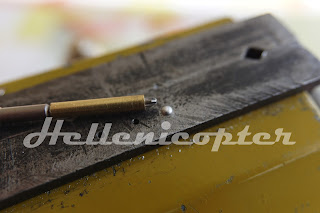Hello,
A small update before the photos of the painted fuselage. At many places on the fuselage I needed to have replicas of cruciform headed screws without having to spent a fortune for real mini screws (they cost a lot of money! - BTW, you can check my provider Knupfer Modell, excellent service!).
Provided that you have watchmaker's screwdrivers (which are also expensive but useful more than once) it is possible to create the form you need on the head of rivets. I use aluminum rivets because they are soft and have the right color when they get exposed during the weathering of the paint. In addition, it is much easier to cut off the excess length inside the fuselage than that of screws made of steel.
Below you can find some photos of the process. It is crucial to have a guide sleeve around the shaft of the screwdriver in order to get good centering of the shape on the rivet's head. I made my sleeve from bronze tube profile that have the right internal diameter. You may need to bevel the sleeve's edges to match the curvature of the rivet's head for best results. Then a small hammer will do the job for the striking ("minting") part.
You may hit the rivet's head twice or more to get the right depth. After the first hit the shape should already be formed so you may not need the sleeve anymore for guiding.
I hope it is useful to some of you.




Cheers,
Hellenicopter
A small update before the photos of the painted fuselage. At many places on the fuselage I needed to have replicas of cruciform headed screws without having to spent a fortune for real mini screws (they cost a lot of money! - BTW, you can check my provider Knupfer Modell, excellent service!).
Provided that you have watchmaker's screwdrivers (which are also expensive but useful more than once) it is possible to create the form you need on the head of rivets. I use aluminum rivets because they are soft and have the right color when they get exposed during the weathering of the paint. In addition, it is much easier to cut off the excess length inside the fuselage than that of screws made of steel.
Below you can find some photos of the process. It is crucial to have a guide sleeve around the shaft of the screwdriver in order to get good centering of the shape on the rivet's head. I made my sleeve from bronze tube profile that have the right internal diameter. You may need to bevel the sleeve's edges to match the curvature of the rivet's head for best results. Then a small hammer will do the job for the striking ("minting") part.
You may hit the rivet's head twice or more to get the right depth. After the first hit the shape should already be formed so you may not need the sleeve anymore for guiding.
I hope it is useful to some of you.




Cheers,
Hellenicopter


Aucun commentaire:
Enregistrer un commentaire